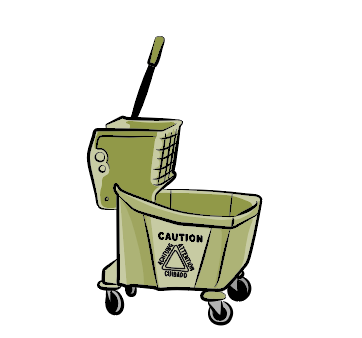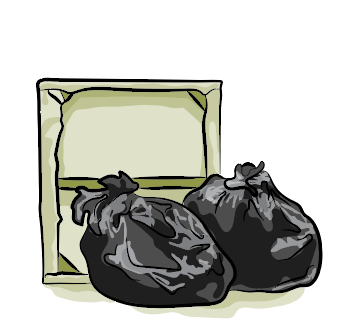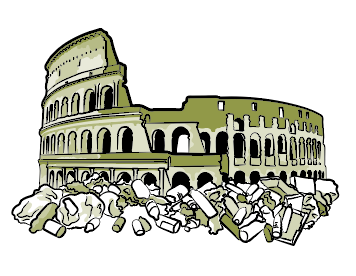Shitting into the past
All ancient cities stand on layers of rubble, waste, and human remains. Rome is no exception. In Sister Stop Breathing, a collection of short fictions centered mostly on the so-called Eternal City, Chiara Barzini weds the seemingly contradictory states of permanence and decay, whether bodily or architectural. “Dead Prime Minister,” for instance, literalizes an undead vibe by introducing a quasi-corpse, “brownish and flaccid,” who retains the ability to “speak and move in small measures.” (Accused of having an affair with a transsexual prostitute and an underage girl, he reasons that “when you’re dead you don’t even know you’re married.”) Former Italian prime minister Silvio Berlusconi’s stink has long lingered in the public consciousness, but Barzini extends it to the city as a whole: surrounded by monuments to the dead, the citizens of present-day Rome are the dead of the future.
“Dead Pope”—separated from “Dead Prime Minister” by a single-page piece called “The Guillotine”—takes place in a “dead city” that both is and is not Rome, following the exploits of a pope whose corpse is paraded around the streets before getting lost and then reappearing under a tree at Villa Pamphili. “Here I am,” he says, which is both a biblical echo and a perfectly natural thing for a dead pope to say.
But knowledge of papal succession, or of the scandals surrounding Italy’s sometime prime minister, or of antiquity in general, is unnecessary for the reader. Sister Stop Breathing has virtually no documentary feel or intent; rather, it takes up the question of how one might create art, or anything at all, while surrounded by artifacts that will outlast everyone who is currently alive, and then some.
Further hints of the stifling force of tradition appear in the guise of the sewage police—“mellifluous, wet people in neoprene uniforms that camouflage themselves as seals from another era,” regulating “the use of ancient pipes in contemporary buildings” against transgressors who “collect raindrops and mix them with urine,” “defecate in bags and throw them out windows,” or even “jump out the window of their smelly bathrooms.” A threat guaranteed to scare Romans, Barzini tells us, is “Your sewage goes into pipes laid in 753 B.C. You are shitting into the past.”
But, she asks, could one do otherwise? Art, shit, and death are the results of linked processes. In Rome especially, new art must not only contend with a massive cultural backlog, but also be absorbed into a space literally crowded with everything since the Etruscans. Sister Stop Breathing understands antiquity as baggage, garbage, waste: the weight and intimidation of culture itself.
Still, garbage is of immense value to archaeologists; ancient trash, according to garbologist William Rathje, provides “insight into the long-term values of civilization.” After enough time, nearly any item that has been cast aside as worthless and that survives—animal bones, pottery shards, mollusk shells, tools, organic material—can make its way into a museum. Unsurprisingly, ancient city dwellers threw their trash wherever they wanted, often causing street levels to rise over time. In Pompeii, trash even accumulated in and around cemeteries, which became the final resting place not only for bodies but for all manner of refuse.
In addition to her reveling in such detritus, there’s a freshness to Barzini’s collection that risks going unnoticed. Take the sewage police supra. It’s worth noting that “ancient pipes” fall under their jurisdiction, specifically the ancient pipes found in contemporary buildings. As backward-looking as these police are, their uniforms made of neoprene, a synthetic polymer developed as recently as the 1930s, function as a gesture toward modernity, right down to neoprene’s prefix.
Barzini has a few ways of dealing with the past, including mocking it, destroying it, moving on (“What am I doing in this attic, scavenging through boxes?” a woman wonders. “Shouldn’t I get a haircut and proceed toward the world?”), and succumbing to despair. In “Vauville,” the collection’s bleak final story, a teenager visits her estranged father in France for the first time, and it’s tempting to read the source of the piece’s bleakness—incest—as a caution relevant to literary art. In strictly artistic terms, incest is a failure of vision, an inability to create something new, something beyond the derivative. The father is a “new man,” yet also “older, lazier.” His daughter has no bathing suit, so he gives her one belonging to his “new wife.” He has traveled to Europe to escape his desires and flee his past, and he has failed on both counts.
As for Rome—capital, city-state, cultural hub, Eternal City—its graveyard remains a graveyard. Its timeless grandeur and decay are present everywhere in Sister Stop Breathing, even in pieces set in Los Angeles and France: for all their prevailing strangeness and their atmosphere of anywhere-and-nowhere, Barzini’s stories are marked by a pungently Roman collision between ancient and modern. The collection succeeds because it doesn’t seek to document history, Roman or otherwise, but rather to reenvision it. In grappling with what has come before, the author displays a deep awareness of the past; by deploying complex historical texture, she manages to change our perception of how its presence can linger.

Maintenance art
Success in the arts may not feel much like a successful ascent of Mount Everest, but the two goals have a few things in common. For one thing, nobody achieves either without group effort. For another, that group’s supporting players may not get the credit they deserve. Often they are women, or young people, or people of color, or members of other marginalized groups, while their beneficiaries—the lead actors and recognized artists and supposed trailblazers—are white and male.
Many writers and artists have noticed the problem; few have addressed it head-on with the verve, and the success, of the gallery artist Mierle Laderman Ukeles, who happened to be raising her first child during the emergence of conceptual and performance art in the late 1960s. After giving birth, Ukeles wanted to keep making and exhibiting, displaying something of her own, something new. But lack of affordable childcare and sexist expectations about housework made those goals seem hard to achieve, even Everestine. Taking care of people and things that already existed—in other words, maintenance—took up almost all of Ukeles’s days.
“I do a hell of a lot of washing, cleaning, cooking, renewing, supporting,” Ukeles wrote in her 1969 Manifesto for Maintenance Art. She couldn’t usually get much time away from these tasks; even if she could, most maintainers could not. Ukeles therefore proposed to “do these maintenance everyday things, and flush them up to consciousness, exhibit them, as Art. I will live in the museum [as] I customarily do at home with my husband and my baby… sweep and wax the floors, dust everything, wash the walls (i.e. ‘floor paintings, dust works, soap-sculpture, wall-paintings’), cook, invite people to eat, make agglomerations and dispositions of all functional refuse.”
That museum show never happened, however. Instead, Ukeles documented, in photographs and in writing, the maintenance that she performed at home, including diaper changing and trash disposal, and turned the documents into their own exhibit. Then she did something similar for the professional maintenance workers who clean and arrange exhibits in New York museums. That work, in turn, brought her to the attention of the New York City Department of Sanitation, where she has served as official artist in residence since 1977. The following year, Ukeles set out to shake hands with every one of the city’s sanitation workers, calling the effort Touch Sanitation. Her role as advocate for maintenance—for sanitation workers and janitors as well as homemakers—was foreshadowed in her manifesto: “The sourball of every revolution,” she wrote, is “who’s going to pick up the garbage on Monday morning?”
Ukeles has earned the respect of art-world giants, though it took a while to achieve; she didn’t have her first solo retrospective until 2016, at the Queens Museum. Her career now looks like an effort to fight the way “the culture confers lousy status on maintenance jobs”—both those done from trucks and those often performed without pay. It also cocks a snook at the rather masculine idea that all good art has to make something utterly new, revolutionary, disruptive, heretofore unknown: the incremental, often repetitious labor of maintenance, she says, whether white- or pink- or blue-collar, deserves at least equal respect.
As for Everest (on which Western explorers left so much trash that at one point it was called the world’s highest dump), after the 2015 earthquakes, the Nepalese government imposed new fines, rules, and litter-collection requirements, and present-day climbers seem to have learned how to pick up after themselves.
Stephanie Burt

Restored faith
In 2003, Elizabeth Gibson found a 1970 Rufino Tamayo painting between two garbage bags near an apartment building in Manhattan. She never learned who had thrown the painting away, but four years later she discovered that the painting was stolen, originally valued at $55,000, and now worth millions. “It’s a real New York story,” the FBI agent on the case told The New York Times.
The word garbage dates back to the 1580s, and originally referred to food waste; later, it began to be used metaphorically to evoke materials deemed to be worthless. (The word trash, meanwhile, has been used in this sense since the late fourteenth century.) But it has since become a commonplace that garbage can contain hidden value, because what distinguishes trash from treasure is merely one’s attitude toward it. Garbage can hold secrets: underneath the plastic, paper, and old takeout containers is the promise of sentimental or monetary riches, if we are willing to unearth them.
What makes the story of the Tamayo piece interesting is not that Gibson received a finder’s fee and that the original owner got her multimillion-dollar painting back, but rather that someone had decided the work wasn’t worth saving. Some artists will discard their work when it doesn’t live up to their standard, but often it’s art thieves who steal paintings from the walls of the greatest museums and relegate them to trash piles when they find they can’t sell the work without revealing their identity.
In 2009, Teisha McNeal bought a signed Picasso for $2 at a Louisiana garage sale. (The seller, who was holding the sale on behalf of a recently deceased art collector, has said she feels ill thinking about the transaction.) An Ohio man bought an original Picasso at a thrift store for $14.14, then later sold it for $7,000. New Jersey native Carl Sabatino found Picasso’s Woman with a Cape, worth more than $10 million, under his aunt’s sewing machine after she died. Considering that Picasso left some forty-five thousand works, the art world’s largest dynasty, it’s almost unsurprising that some would end up drifting through the world unvalued.
When this happens, we tend to wonder how a buyer or seller could fail to notice the value of a work that is obviously worthy of attention. The people who discovered or bought the Picassos assumed they were replicas, but were swayed nonetheless by their aesthetic pull; that is, their misguided perception was only of the works’ monetary value. Their aesthetic value, irrespective of whether or not they were authentic Picassos, was in a sense their value. Had they been valued differently, it’s likely none of Picasso’s works would have been lost at all.
This is why we balk at stories of artists destroying their own work. In his Paris days, Picasso burned his paintings for kindling when temperatures fell. Monet took a knife to at least fifteen of his famous water lilies days before they were scheduled to be in a gallery show. Van Gogh was known for scraping his canvases clean and starting over rather than throwing them away. Had they discarded these works instead of eliminating all traces of their existence, we would have been able to preserve the value the artists themselves failed to see.
And who would have been right? Art and value are slippery bedfellows. In 2004, an employee at the Tate Britain threw away a plastic bag that was part of an installation by Gustav Metzger. In 2014, a cleaner in Italy threw away the newspaper, cardboard, and cookie pieces that were part of a piece by Sala Murat. Artworks that can be mistaken for pedestrian materials, or garbage, can make us question the authority of the artist. But they can also stand as a testament to art’s ability to be so true to life that we mistake its veracity for worthlessness.
Kayla Dean

California redemption value
What makes you think your story is worth telling? What makes you so special? Accosted by these bad questions, memoir writers report various responses: they feel like crap, they spit practiced patter, they stonewall. In their own minds, they have no choice but to answer Yes, my story is worth telling because of x; I’m special because of y. But also, for the love of consensual reality, my story is the only one I have, so it’s the one for me to tell. Who knows? Perhaps you’ll find yourself in it too.
In his memoir, Garbage: The Saga of a Boss Scavenger in San Francisco, Leonard Dominic Stefanelli decides to let his natural bullheadedness shine through in telling his story, that of a superstar garbageman in the decades when small operators of the “one horse, one wagon, one Italian” type coalesced into San Francisco’s mighty Sunset Scavenger Company, later renamed Recology, whose efficiently mechanized trucks collect the city’s separated waste streams today. Stefanelli, who passed away in April 2018, had hold of a juicy universal truth, and he knew it: “Garbage,” he writes in the introduction, “is truly the common denominator of all people in the world.” (In fact he writes “dominator,” which is either a very good typo or a great observation: the feeling of being bullied by one’s trash is universal, whether it’s during a city council public hearing on landfill location or while scooping out the cat box.)
Stefanelli’s 1950s street-level world is intense: the reader follows the narrator onto Truck 27, smells the hot truck bed with its wriggling maggots spilling down the garbageman’s back, dreads the razor blades that might be hiding in the cuverta burlap sacks slung over their shoulders. Of driving the open-cab trucks, he remarks, “I noticed that the windshield wipers were on both sides of the glass, and at first, I thought that was unusual. But when the first rains came, I realized then that it rained on both sides of the windshield.”
But Garbage also presents an ant-farm perspective of the standard image of San Francisco: the part people usually don’t want to see. Up three flights of a Fillmore apartment house’s back staircase, across the puzzle-map of where to put all the city’s trash after it is collected. In the middle, however, the book turns away from the garbage route in a section about Stefanelli’s 1965 promotion to company president, via what he calls a “revolution” in the Sunset Scavenger boardroom. It isn’t as sexy as a history of the Pride Parade or anything, but it still contributes a new layer of understanding of the concept of “city.” Traveling sideways through shareholder equity talk and explanations of industry horse-trading, the narrative makes frequent stops for lunch at Bertolucci’s, and reaches tentacle-like beneath Mountain View’s new golf courses and the glamorous Shoreline Amphitheatre—where some of the waste ends up. It also follows Stefanelli across the planet as he considers solid-waste disposal systems in the late 1960s and early ’70s: most were bad. Some were merely misplaced, like the South American ones that make good compost that is not needed because the soil is already rich. Several are interesting; even today, Recology uses a methane-recovery system inspired by Stefanelli’s trip to Munich. Tokyo, he says, has a spectacular mess of a dump called Dream Island—the same dump fictionalized in Isle of Dogs—and a system of compacting refuse into tar-covered blocks that appear to be killing the rice fields into which they’re packed as part of an attempt at land reclamation.
For all its shoptalk, though, Garbage never loses sight of the tension between those persistent “You think you’re so much better than us?” questions and the answers. Stefanelli’s cousin and mentor, Benny Anselmo, supplied a philosophical observation on a drive across the Bay Bridge in the 1950s: “Look at that city, Lenny. The garbagemen are like the city’s asshole. If we don’t go to work every day, the city will shut down like you and I would if our assholes didn’t function.”
Garbage is full of random narrative repetitions, a jarring use of direct address, and a weird overreliance on the word facetiously—the text is severely underedited. But it’s compelling anyway, pulling its high drama from the Genoese-led, anti-environmentalist, often backstabbing upper echelons of Northern California garbage collection. A custom Cadillac appears, deals are wheeled, and the recurring “watermelon juice down the butt crack” bit delivers a gag-a-maggot punch. In fact, the satisfaction of the read throws the book’s opening words into bright relief: “There should be no rhyme or reason that anyone would want to write about, let alone share a man’s life in the ‘garbage business.’”
These words are alarming, as if the walls of a compactor were grinding in to crush the spirit of writing itself, or at least that of anyone who’s been asked what makes their story worth writing. How does the undermining of the would-be writer exist so universally? Stefanelli was a teenager when he stepped into the business of his grandparents’ first-generation Italian immigrant community, who could find no other work in the face of discrimination. In his own words, he spent time operating at “the lowest possible rung on the social ladder.” But his twenty years as president of a multimillion-dollar company are relevant too: the final photo is of Stefanelli standing with a powerful politician. He’s been high; he’s been low; he’s proud of it all—and still the shame and devaluation implied in those bad questions reached him. “Rhyme and reason” dictated that he should not write his garbage story.
But—a writer’s maxim—while not every story is good to read, you have the right to tell every story you’ve lived. The art is in the execution, but silence is a fundamental problem. So, notice: without a lot of help—in this case a head-start push from some heavy-duty writers (Stefanelli credits historians Ken Sproul and Kevin Starr with helping him realize at last that “my story is in fact worth sharing”)—the extraordinarily interesting story of Leonard Stefanelli could have remained underground. It might have stayed in the trash.
Today, golf-course grass sprouts from sanitary fill, San Francisco has only ever suffered one day without garbage collection, and the company this guy built runs an artist-in-residence program on top of maintaining the 80 percent diversion rate that makes San Francisco the best recycler in the country. In some places, Stefanelli’s story is a ripping yarn; in others, it’s an irreplaceable document. Garbage goes behind the Iron Curtain, back to the remote village of Fontanarossa, and into the details of an industry crucial to all human life on the planet. Anyone who doesn’t think it’s worth sharing is probably an asshole.





